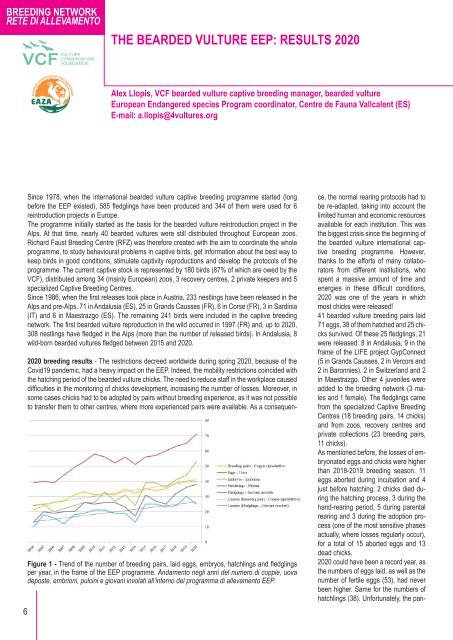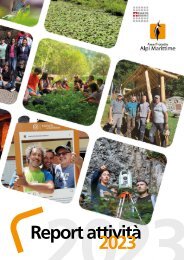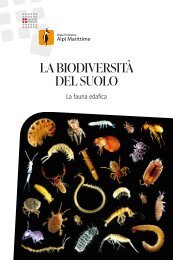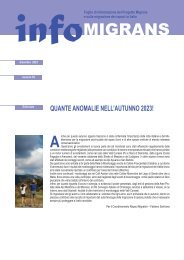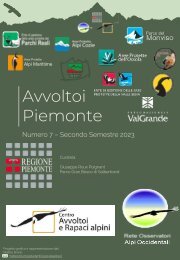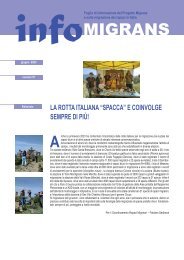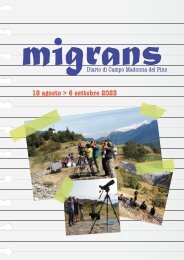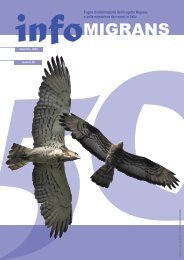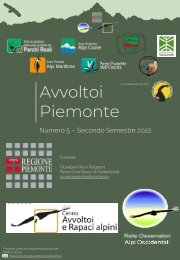infoGIPETO n.37 |dicembre 2020
Periodico d'informazione sul progetto di reintroduzione del gipeto.
Periodico d'informazione sul progetto di reintroduzione del gipeto.
You also want an ePaper? Increase the reach of your titles
YUMPU automatically turns print PDFs into web optimized ePapers that Google loves.
BREEDING NETWORK<br />
RETE DI ALLEVAMENTO<br />
THE BEARDED VULTURE EEP: RESULTS <strong>2020</strong><br />
Alex Llopis, VCF bearded vulture captive breeding manager, bearded vulture<br />
European Endangered species Program coordinator, Centre de Fauna Vallcalent (ES)<br />
E-mail: a.llopis@4vultures.org<br />
6<br />
Since 1978, when the international bearded vulture captive breeding programme started (long<br />
before the EEP existed), 585 fledglings have been produced and 344 of them were used for 6<br />
reintroduction projects in Europe.<br />
The programme initially started as the basis for the bearded vulture reintroduction project in the<br />
Alps. At that time, nearly 40 bearded vultures were still distributed throughout European zoos.<br />
Richard Faust Breeding Centre (RFZ) was therefore created with the aim to coordinate the whole<br />
programme, to study behavioural problems in captive birds, get information about the best way to<br />
keep birds in good conditions, stimulate captivity reproductions and develop the protocols of the<br />
programme. The current captive stock is represented by 180 birds (87% of which are owed by the<br />
VCF), distributed among 34 (mainly European) zoos, 3 recovery centres, 2 private keepers and 5<br />
specialized Captive Breeding Centres.<br />
Since 1986, when the first releases took place in Austria, 233 nestlings have been released in the<br />
Alps and pre-Alps, 71 in Andalusia (ES), 25 in Grands Causses (FR), 6 in Corse (FR), 3 in Sardinia<br />
(IT) and 6 in Maestrazgo (ES). The remaining 241 birds were included in the captive breeding<br />
network. The first bearded vulture reproduction in the wild occurred in 1997 (FR) and, up to <strong>2020</strong>,<br />
308 nestlings have fledged in the Alps (more than the number of released birds). In Andalusia, 8<br />
wild-born bearded vultures fledged between 2015 and <strong>2020</strong>.<br />
<strong>2020</strong> breeding results - The restrictions decreed worldwide during spring <strong>2020</strong>, because of the<br />
Covid19 pandemic, had a heavy impact on the EEP. Indeed, the mobility restrictions coincided with<br />
the hatching period of the bearded vulture chicks. The need to reduce staff in the workplace caused<br />
difficulties in the monitoring of chicks development, increasing the number of losses. Moreover, in<br />
some cases chicks had to be adopted by pairs without breeding experience, as it was not possible<br />
to transfer them to other centres, where more experienced pairs were available. As a consequen-<br />
Figure 1 - Trend of the number of breeding pairs, laid eggs, embryos, hatchlings and fledglings<br />
per year, in the frame of the EEP programme. Andamento negli anni del numero di coppie, uova<br />
deposte, embrioni, pulcini e giovani involati all’interno del programma di allevamento EEP.<br />
ce, the normal rearing protocols had to<br />
be re-adapted, taking into account the<br />
limited human and economic resources<br />
available for each institution. This was<br />
the biggest crisis since the beginning of<br />
the bearded vulture international captive<br />
breeding programme. However,<br />
thanks to the efforts of many collaborators<br />
from different institutions, who<br />
spent a massive amount of time and<br />
energies in these difficult conditions,<br />
<strong>2020</strong> was one of the years in which<br />
most chicks were released!<br />
41 bearded vulture breeding pairs laid<br />
71 eggs, 38 of them hatched and 25 chicks<br />
survived. Of these 25 fledglings, 21<br />
were released: 8 in Andalusia, 9 in the<br />
frame of the LIFE project GypConnect<br />
(5 in Grands Causses, 2 in Vercors and<br />
2 in Baronnies), 2 in Switzerland and 2<br />
in Maestrazgo. Other 4 juveniles were<br />
added to the breeding network (3 males<br />
and 1 female). The fledglings came<br />
from the specialized Captive Breeding<br />
Centres (18 breeding pairs, 14 chicks)<br />
and from zoos, recovery centres and<br />
private collections (23 breeding pairs,<br />
11 chicks).<br />
As mentioned before, the losses of embryonated<br />
eggs and chicks were higher<br />
than 2018-2019 breeding season. 11<br />
eggs aborted during incubation and 4<br />
just before hatching; 2 chicks died during<br />
the hatching process, 3 during the<br />
hand-rearing period, 5 during parental<br />
rearing and 3 during the adoption process<br />
(one of the most sensitive phases<br />
actually, where losses regularly occur),<br />
for a total of 15 aborted eggs and 13<br />
dead chicks.<br />
<strong>2020</strong> could have been a record year, as<br />
the numbers of eggs laid, as well as the<br />
number of fertile eggs (53), had never<br />
been higher. Same for the numbers of<br />
hatchlings (38). Unfortunately, the pan-


